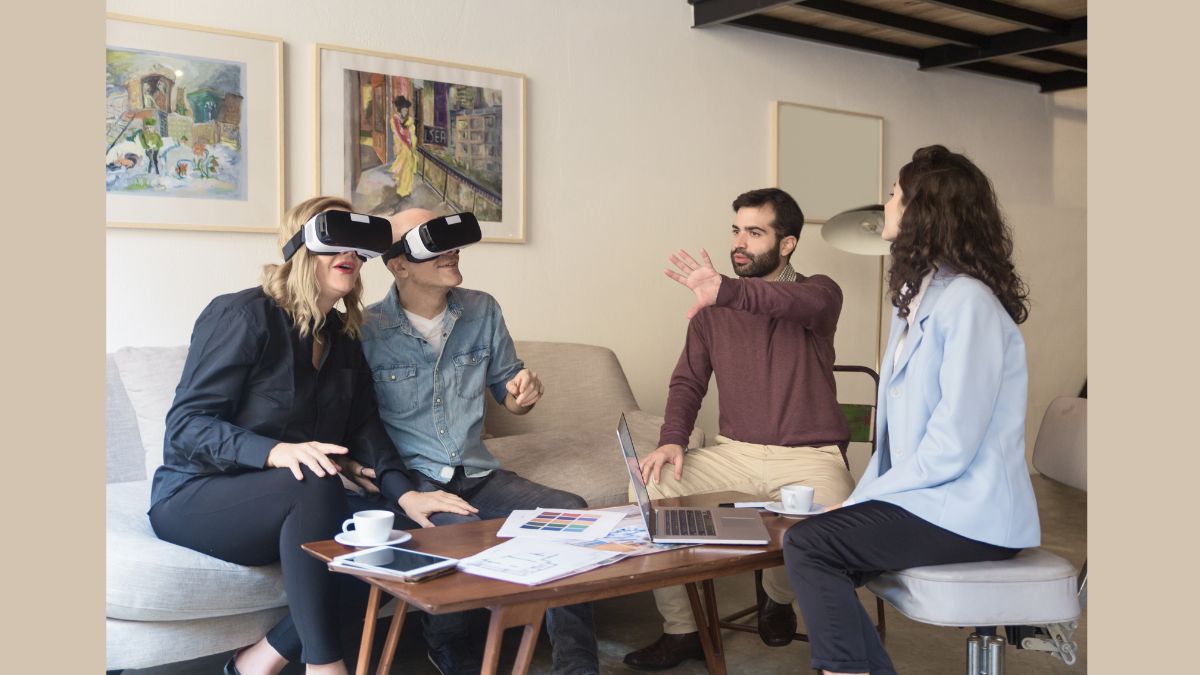Strap on a headset and you’re transported to alien skylines or haunted basements.
Yet the studios building those realms juggle far less glamorous problems.
Spiraling budgets, fickle hardware markets, and stomach‑churning frame drops.
AR/VR gaming companies in the USA have learned that innovation is only half the battle.
The other half is ruthless process control.
By dissecting each obstacle and building tailored workarounds, they turn potential deal‑breakers into competitive edges.
High Development Costs and Resource Demands
Creating immersive 3D environments requires larger, more specialized teams
Photorealistic textures, physics‑driven interactions, and spatial audio all demand niche skill sets. A single VR level might need three environment artists, a technical sound designer, and a shader expert just to feel believable.
Studios offset payroll spikes by adopting hybrid models: core artists handle signature assets while external partners sculpt background props under tight style guides. Quality stays high, but internal headcount remains lean.
Accessing high‑end hardware and testing platforms increases overhead
Developers need multiple headset versions, haptic vests, and motion‑capture rigs for every prototype cycle. The shopping list balloons long before the first trailer drops.
To control spend, companies rotate hardware through sprint rooms like a lending library and negotiate shared lab spaces with local universities. Capital expenditure transforms into scheduled, predictable usage fees instead of surprise invoices.
Studios manage costs by using modular asset pipelines and outsourcing select components
Modularity turns a dragon’s wing, claw, and fire‑breath into reusable building blocks. When a new quest calls for wyverns, artists drag‑and‑drop prebuilt modules instead of starting from scratch.
Noncritical tasks: LOD creation, collision pass, texture upscaling, shift to trusted vendors abroad, freeing the in‑house team to refine hero assets that anchor brand identity.
Limited Consumer Hardware Adoption
Expensive headsets and inconsistent device compatibility reduce audience size
A flagship game might thrill on a cutting‑edge headset yet miss half the market stuck on older gear. For every extra polygon, potential customers slip through the cracks.
Studios monitor headset adoption curves quarterly and benchmark frame rates on the three most common devices. Visual ambition scales inside those limits, ensuring no player feels short‑changed.
Hardware constraints limit design freedom and performance potential
Mobile VR chips choke on complex shaders. Eye‑tracking isn’t ubiquitous. Designers who ignore these ceilings risk undercooked experiences or brutal reviews.
Teams adopt “graceful degradation.” If foveated rendering isn’t available, the engine swaps to fixed eye buffers. Players with advanced rigs keep their wow factor, while baseline users still enjoy stable performance.
Developers overcome this by building cross‑platform experiences with scalable visuals
Engines preload texture packs at multiple resolutions. A lightweight pack serves entry‑level headsets; a 4K pack streams on high‑end rigs. Code paths toggle features based on a simple capability handshake at launch.
The result: one SKU hits multiple storefronts, marketing budgets stretch further, and user communities grow instead of fragmenting.
Motion Sickness and User Comfort Issues
Poor frame rates and latency can lead to nausea and discomfort
When head rotation outruns pixel updates, the brain screams mismatch, and players rip off headsets in frustration. Trashcan moments tank retention faster than any gameplay flaw.
Studios institute a “90 fps or bust” mandate. Build reviews halt if frames dip below target, reducing rework later and saving reputations at launch.
User retention drops if early experiences are physically unpleasant
A first‑timer’s bad spin jump can sour them on the entire genre. Word‑of‑mouth shrinks and refund rates climb.
Tutorials now introduce comfort settings at minute one, snap turning, vignette during locomotion, and seated‑play toggles. Giving users agency over motion tricks brains into calm acceptance.
Teams solve this with high‑FPS rendering, ergonomic design, and comfort‑first UX
Developers budget GPU cycles like gold, prioritizing input latency over extra particle bursts. Level designers widen doorways and flatten staircases to minimize sudden pitch changes.
UX researchers run bio‑feedback tests, correlating heart‑rate spikes with specific mechanics. Offending designs iterate until biometrics show steady calm, translating research into real‑world comfort.
Complex Development and Integration Challenges
Integrating real‑world spatial mapping or hand tracking adds layers of complexity
Every new sensor API brings edge cases: reflective floors, low‑light rooms, or users who gesture wildly off‑axis. Testing matrices explode overnight.
Studios build simulation rigs that mimic tricky environments mirrored walls, dim basements to catch edge crashes before public release.
Existing engines often require heavy customization for AR/VR
Traditional engines love flat screens. Embedding six‑degrees‑of‑freedom cameras and per‑eye distortion shaders forces plugin gymnastics.
Teams maintain internal forks of popular engines, packaging custom XR modules into reusable templates so each new project inherits hard‑won fixes without re‑writing.
Companies rely on proprietary toolkits, middleware, and custom‑built frameworks to close the gaps
Middleware stitches haptic feedback, eye tracking, and spatial audio into one coherent pipeline. When vendors update SDKs, only the middleware requires a patch; core game logic stays untouched.
This abstraction shields projects from vendor churn and accelerates prototyping, letting creative teams test ideas days after inspiration instead of weeks.
Fragmented Ecosystem and Platform Lock‑In
Building separately for Meta, Apple, HTC, and others increases development time
Different input methods, store policies, and performance targets splinter QA schedules and inflate certification loops. A bug fixed on one headset may reappear on another.
Engine‑level abstraction layers convert platform quirks into unified API calls. Developers script once, and the layer translates differences in controller haptics or asset packaging behind the scenes.
Closed ecosystems restrict monetization and feature access
Revenue shares vary, storefront discoverability algorithms hide indie gems, and native APIs lock key social features to proprietary realms.
Studios hedge by launching companion mobile apps and web portals, cross‑promotions drive traffic regardless of storefront gatekeepers.
Developers mitigate this by focusing on engine‑level abstraction and open standards
OpenXR, WebXR, and GLTF asset pipelines gain priority in tech roadmaps. The more portable the underlying tech, the less power any single platform wields over timelines or features.
Long term, this portability builds resilience against sudden policy shifts, what works today still works tomorrow, even if a vendor pivots strategy.
Difficulty in Monetizing Immersive Experiences
Users are still hesitant to pay premium prices for short or experimental titles
Consumers compare VR prices to 60‑hour flatscreen epics. Shorter playtimes need creative value propositions to justify similar tags.
Studios bundle DLC roadmaps upfront, promising episodic content drops that turn three‑hour launch experiences into season‑long journeys.
In‑app purchases and traditional ad models don’t always translate to VR
Floating billboards break immersion, and shoehorning loot boxes into story‑driven adventures feels tone‑deaf.
Teams experiment with cosmetic upgrades visible in social hubs or multiplayer lobbies – vanity that doesn’t shatter immersion. Brands sponsor limited‑edition skins, injecting revenue without intrusive ad spaces.
Studios experiment with hybrid monetization, brand partnerships, and live event integrations
Live concerts, esports tournaments, and real‑time art exhibits drive ticket sales inside persistent VR worlds. Brand partners fund these events, offsetting development costs while users perceive genuine value.
Hybrid models mix one‑time purchases, season passes, cosmetic microtransactions, and sponsored experiences, smoothing revenue curves across a game’s lifespan.
Talent Shortages and Hiring Gaps
Experienced AR/VR developers are still a niche talent pool
Few engineers have shipped multiple XR titles, making senior candidates rare and expensive. Startups compete with big tech for the same resumes.
Studios cultivate apprenticeship programs junior developers rotate through specialty pods under veteran mentorship, building internal pipelines faster than external poaching can drain them.
Recruiting in AI, 3D design, and spatial computing is highly competitive
AI researchers who can optimize foveated rendering or procedural content are wooed by automotive and med‑tech giants.
Teams widen their nets globally, leveraging remote setups and asynchronous workflows to capture talent where it lives, preserving budget and diversity.
Companies invest in training programs, remote talent, and cross‑functional upskilling
Internal workshops teach traditional 3D artists the quirks of VR shaders, while software generalists learn spatial math through gamified challenges.
Cross‑skilled staff pivot smoothly between prototypes, preserving institutional knowledge and reducing onboarding time for every new concept.
Regulatory and Safety Concerns
Data collection via AR/VR raises privacy red flags
Eye‑tracking, biometric feedback, and room scans create deeply personal datasets. Mishandling could spark headline scandals or crippling fines.
Studios adopt privacy‑by‑design pipelines: data stays device‑side unless anonymized and consented. Clear toggles let players decide exactly what leaves the headset.
Legal gray areas exist around biometric tracking and player boundaries
In mixed‑reality shooters, what happens if a user inadvertently hits a passerby? Biometric laws differ across states, complicating nationwide launches.
Legal teams partner from the prototype stage, advising on safe‑zone defaults and flagging features that require location‑based opt‑ins or parental gates.
Studios build transparent consent flows and collaborate with legal teams early in development
In‑game pop‑ups detail why eye‑tracking data improves targeting and how it stores only heat‑map aggregates. Users skip legalese confusion and grant informed permission, reducing backlash risk.
Early legal alignment also speeds platform approvals, as compliance boxes are ticked proactively rather than during last‑minute QA crunch.
Breaking Barriers, One Innovation at a Time
AR/VR gaming challenges multiply like portal levels, but so do the solutions. American studios stretch budgets with modular pipelines, tame sickness through comfort‑first design, and sidestep hardware silos via abstraction layers.
Every obstacle overcome makes immersive worlds more accessible, profitable, and comfortable, bringing the future of play from sci‑fi conjecture to living‑room reality.
Why keep dreaming when you could be creating? Devsinc turns game visions into visual masterpieces. Their artists have powered 3000+ projects across 5 continents. Stop watching competitors leap ahead. Contact Devsinc today and unlock art that captivates players worldwide.










